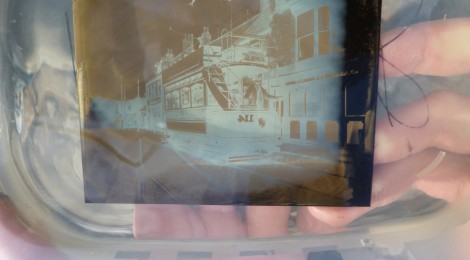
More on Tintypes – traditional photography at Beamish…
Andy Martin has had another session using the Victorian era wet-plate collodion photography technique.
Below: The mobile dark room and studio! To the left is water for rinsing the plates, centre (in the van) is the portable dark room, to the right is a table of materials. Andy is preparing the wet plate in the dark room.
Below: Pouring the collodion onto a thin sheet of aluminium – a modern compromise for convenience – originally glass or black japanned tin would have been used. It is then taken into the dark room for loading into the camera plate holder.
Below: The camera, sans plate holder. It’s a c1940s/1950s Graflex Crown Graphic press camera with a 5×4 double dark slide modified to take quarter plate sized sheets of metal or glass. The lens, whilst comparatively modern (1960s!) is built to a similar design of the brass lenses used in the mid-late 1800s so the resulting images will have a similar look and feel to original plates. It is hoped in the future that the process could be occasionally demonstrated during Museum opening hours with an authentic camera, tripod and equipment from the time, maybe during one of the Museum’s special events.
Below: Setting up a shot, with 114 and Stuart taking their position and the camera set up for the composition.
Below: Loading the wet plate into the camera.
Below: Making an exposure, anywhere from 15 – 25 seconds for a view such as this in late afternoon, overcast conditions. With neither a shutter in this camera or lens, exposure is achieved by removing the lens cap from the lens for the required time.
Below: A view of 114 posed for the session outside the Sun Inn, advertising board temporarily reversed for this shoot (it is back to ‘Forty Years of Service’ – marking the 40th anniversary of the Beamish Tramway this year.
Below: The exposed plate is then taken to the dark room and unloaded into a tray of Iron Sulphate based developing solution. Once the image has appeared, usually after 15-20 seconds, it is then rinsed of developer and placed in a tray of fixer, no longer needing shielding from light, as the image slowly emerges, initially as a negative and then turning into a positive. The image is still a mirror image however. Once dried, the plate is varnished with a Sandarac (tree resin) and lavender oil based varnish to protect the fragile emulsion, as well as giving more depth and contrast to the image.
Below: A photograph of the dried and varnished plate, showing the reversed scene…
Below: … and the scene reversed but otherwise not tampered with in any way. Interestingly, the rendition of colours is very much altered – compare these views with the colour view of 114 above and note the waist panel (which is yellow) has been rendered as a dark shade – for more on such distortions of colour in old photographs, see the articles on 114 and its repaint in the’Downloads/Articles section of the blog.


















Excellent Andy – very interesting. We’ll pose for you any time!
Fantastic – i’ve been using my 1913 model Kodak camera (built in 1917) at Beamish for a few years now, and at other sites, but at 50p a shot i’m very picky about where I take photos and prefer to have a suitable background as well as subject so most are taken at Beamish
There’s a few here;
http://www.flickr.com/photos/roblangham/sets/72157626744154788/